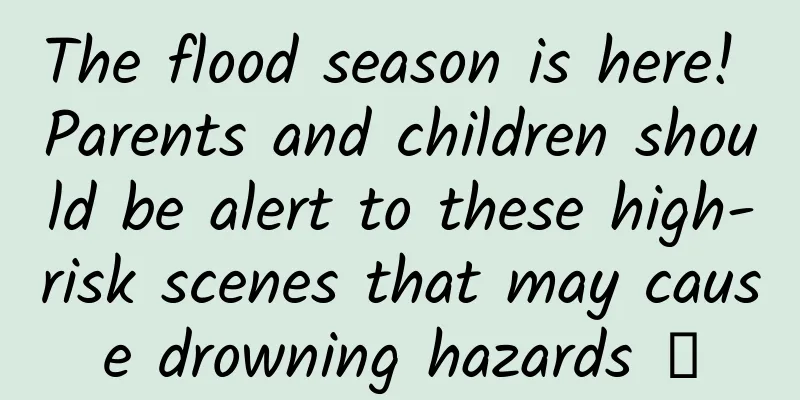The flood season is here! Parents and children should be alert to these high-risk scenes that may cause drowning hazards →

|
During the flood season, children are more likely to wade and swim, and drowning accidents are at a high risk. I believe many parents will remind their children to avoid dangerous outdoor waters, but often ignore the drowning risks hidden at home or other indoor places. Let's first look at a few test questions: 1. Have you ever left your child alone in the bathtub (even if it was only for a short time, such as to answer a phone call or get something)? 2. Did you remember to close the doors of the bathroom and laundry room to prevent young children from entering at will? 3. Do you place uncovered buckets, basins, or other containers filled with water anywhere? 4. Do you have an open fish tank or aquarium at home with a high water level and no protective measures? 5. Have you ever let your young child play alone in a small swimming pool or bathtub at home, even if the water level is not high? If your answers are mostly "yes", you must be vigilant. A shocking fact is that many young children drown at home. According to statistics from the Ministry of Public Security and the National Health Commission, the most common places for drowning for infants and young children aged 4 and under are water containers at home, such as indoor washbasins, water tanks and bathtubs . Today is World Drowning Prevention Day. Let us avoid these "water play" misunderstandings and give children a safe and happy summer experience. 01 If children learn to swim, can they prevent drowning? Being able to swim does not mean you will not drown. Fatigue, cramps, changes in water flow, low water temperature and other factors can lead to poor physical condition. Even underwater weeds and mud can trap swimmers and cause drowning accidents. Therefore, even if you are good at swimming, you should remain vigilant, avoid acting alone, and carry life-saving equipment. 02 When a child is drowning, he will shout for help. Can adults just watch from a distance to ensure their safety? In movies and TV shows, there are often scenes of drowning people struggling and shouting for help, but drowning actually happens quickly and silently. The tension after drowning can prevent the drowning person from shouting for help, especially for children, who are more likely to choke on water if they shout for help. If you find someone, especially a child, suddenly quiet in the water, or lying or standing in a daze in the water, be alert, as this may be a sign of drowning. 03 There is only a little water in the basin. Is it okay to leave it on the ground for a short time? Even if the bathtub or basin at home only contains shallow water (even if the water is only 2-3 cm deep), or even an uncovered toilet, there is a risk of drowning. Since children's bodies are not yet fully developed, as long as the water can submerge their faces, they may suffocate and drown. In addition, basins placed on the ground for a long time are prone to breeding bacteria, which is not conducive to family hygiene. Therefore, after giving your child a bath, drain the water in the bathtub or tub immediately, cover the toilet lid, and remember to cover the water tanks and wells in and around the home. 04 Can using a swimming ring prevent drowning? Although a swimming ring can provide buoyancy and reduce the risk of drowning to a certain extent in shallow or calm waters, it is not a professional flotation device and cannot completely replace swimming skills or the ability to respond to emergencies. If the swimming ring is damaged, leaking, or of poor quality, and the user cannot swim or has insufficient self-rescue ability, he or she may not be able to respond to unexpected situations even with a swimming ring. While enjoying the coolness of summer, safety must be put first. At all times, parents are the first responsible person for their children's safety. Parents or caregivers should always keep in mind the "nine-word formula" for effective child care: close distance, no distraction, and uninterrupted . Through scientific cognition and correct behavior, we can more effectively avoid drowning hazards, build safe waters, and protect life safety. Planning: Yan Dong Reviewer: Tang Qin, Deputy Secretary-General of the Expert Committee of the Chinese Medical Association, Senior Researcher, National Health Science Expert Produced by: Popular Science China x Chinese Medical Association The pictures and cover picture of this article are from the copyright gallery. Reprinting and using them may cause copyright disputes. |
<<: Solar hydrogel: the "water cycle master" for greenhouse cultivation
Recommend
The reason I recommend you to eat more pears, just one is enough!
In the golden autumn, the weather is slightly dry...
Case Study: Creative Guide for Video Advertising!
Through the three-step advertising communication ...
Make every word of your product copy worth its weight in gold!
Words appear in every corner of our daily lives. ...
Accurate CPA profit-making gameplay, a money-making project suitable for novices
I have found that many of my friends have the hab...
Why don’t brands tell stories in their advertisements nowadays?
From the perspective of viewing experience, the a...
Xiaomi TV head Wang Chuan: LeTV model is coming to an end
Introduction Wang Chuan, co-founder and vice pres...
Magical wormholes, more than just science fiction
Many people must have heard of "wormholes&qu...
Old School Seo: Baidu Domination Course "Search Engine Promotion System Can Be Replicated to Build a Precise Passive Traffic System" with Tools
Old-school Seo: Baidu screen domination and traffi...
Why is it so cold this year? When will the market pick up in 2022? Attached the latest news
In recent times, cold air has been moving south v...
How much does it cost to produce a Korla e-commerce mini program? Korla e-commerce applet production price inquiry
WeChat Mini Program is an application that users ...
The United Nations also celebrates the Spring Festival! The General Assembly resolution designates the Spring Festival as a United Nations holiday
On the 22nd local time, the 78th United Nations G...
Guide for the National Day holiday, Youji uses VR to give you a different kind of fun
2016 can be called the first year of VR. With onl...
Why did the old man, who was in good health, die soon after falling down?
In the past two days, many places have welcomed s...
Hyundai Motors brings a hydrogen fuel cell car with a range of 800 kilometers
It’s another CES Asia show, which is more like a ...
Analysis of Tik Tok short video products!
This article mainly analyzes the product developm...









